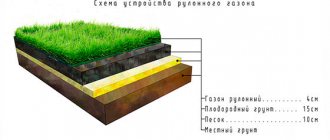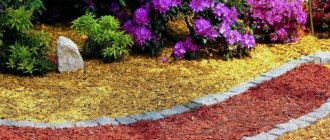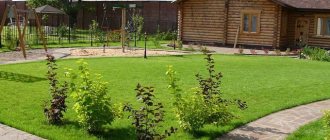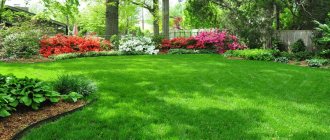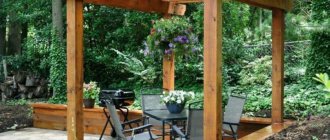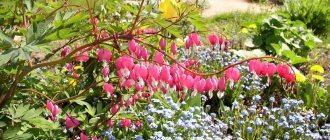- Scope of application of artificial grass in the country
- Video: how to choose artificial turf
- Artificial turf: advantages and disadvantages of grass
- How to choose artificial turf: tips and tricks
- Characteristics and types of artificial turf
- Benefits of artificial lawns
- Laying synthetic turf
- Video: how to choose artificial turf
Every city dweller dreams of having a “Beautiful Dacha” surrounded by greenery. But not every one of them represents the full scale of work associated with the care and maintenance of the proper appearance of the territory adjacent to the house. One of the components of a beautiful green yard is thick and lush grass. But what if for some reason you can’t grow or care for natural grass? There is a solution, and it is called “artificial turf.” In this article we will talk about how to choose an artificial lawn and how to care for it.
Artificial lawn grass.
Artificial turf is a modern synthetic surface made from polyethylene or polypropylene fibers and is an excellent alternative to a natural green lawn. Today, this material is widely used not only in arranging sports fields, but also in decorating personal plots. The great popularity of artificial grass is due to its excellent performance characteristics, attractive appearance and other advantages.
Benefits of artificial turf
There are a number of advantages due to which artificial turf has become widespread:
- Artificial grass has a long service life.
- Even an inexperienced craftsman can easily carry out the work of laying grass.
- Ideal for decorating places with plenty of sunlight or, conversely, shady areas.
- The manufacturing technology provides for the creation of a durable coating that is resistant to mechanical stress.
- Large selection of shapes and textures. You can choose an artificial lawn to suit every taste at Leroy Merlin.
- The use of artificial turf in a garden plot eliminates the use of watering, mowing and maintenance systems. And this, in turn, eliminates unnecessary financial costs.
The presence of these advantages determines the wide popularity of synthetic canvas among landscape designers.
Artificial grass - colors, parameters, purpose
Artificial grass, which has a carpet-like texture, is also available in many varieties. There are different color versions available in the market, so we will get it in many shades of green, as well as red, black, grey, white, yellow, blue or silver.
Thanks to this, it can be easily adapted to the arrangement of the entire interior. Of course, artificial grasses vary not only in color, but also in weight, structure and purpose.
Grass intended for interior use on a deck or balcony will have different parameters than grass that is used in the front of the house or for a playground.
Especially the latter must have greater strength and a much more compact structure because it must withstand intensive use.
Rolls of artificial grass are available in stores and come in a variety of widths, usually from 1 to 4 m, as well as pre-made square or rectangular pieces in a variety of sizes.
Their weight typically ranges from 1050 g/m2 to approximately 2100 g/m2.
The price also depends on the thickness and weight of such flooring.
Disadvantages of artificial turf
Unfortunately, even synthetic fabric is not without its drawbacks:
- High price.
- Artificial turf easily heats up in direct sunlight, and in addition, heats the surrounding air.
- Once removed, the lawn cannot be recycled, which is not a plus from an environmental point of view.
The fairly high cost of materials limits the too frequent replacement of the lawn.
How to care for artificial grass?
There is no need to worry about the quality of artificial grass, although it is worth remembering to maintain it regularly.
It should be regularly cleaned of dirt and debris, for example with a vacuum cleaner in the case of home carpets.
Recommendations for the care of artificial turf should:
- Brush your grass regularly with a stiff brush (not wire bristles) to keep it in good condition and straighten the fibers. It is enough to carry out these events once every 3 months. Most often this is done only in commercial real estate.
- Remove debris such as leaves, weeds, etc. regularly.
- All vegetation (leaves, weeds) can be removed by hand using a soft-tipped rake or blower.
- Dirt and stains can be removed with a brush and a 3% ammonia solution, greasy stains with ethyl chloride, organic stains with warm water and vinegar or soap. You can use rags, mops, and soft brushes to clean the grass.
- Dust and dirt are easily washed off with water. Artificial grass should be washed from time to time, especially on hot days, but this is not as necessary as with natural lawns.
- For stubborn stains, such as oil stains, it is worth using professional grass cleaning services offered by specialized companies.
It is also not recommended to leave open fires, hot barbecues or fireworks on synthetic lawns.
You should also avoid placing furniture with sharp edges on artificial grass, which could damage the fibers or backing.
In turn, to avoid discoloration, do not use oxidizing or acidic agents, and do not expose the grass to sunlight through glass or metal objects.
Mechanical deicing or intensive use at temperatures below minus 15 degrees Celsius is not permitted.
Types of artificial turf
Depending on the installation method and subsequent operation, all types of synthetic coatings are divided into three types:
- Infill lawn.
- Not a backfill model.
- Mixed coating option.
The choice of synthetic fabric depends on its main characteristics and the wishes of the owner of the site.
Artificial grass price
You can purchase artificial grass at any home improvement or gardening store, directly at the manufacturer’s premises, or via the Internet.
How much does this artificial grass cost?
This depends on several factors:
First of all, this is influenced by its quality, as well as the quantity you need.
The popularity of artificial grass is explained, among other things, by its attractive price. This is due to the fact that it is a relatively cheap surface compared to others and, moreover, it does not require additional costs associated with its maintenance.
There is artificial grass for sale for personal use, as well as grass for sports fields.
Prices for such synthetic artificial grass can start from RUB 490/m2, but if you want a higher quality surface, you should consider costs of RUB 2,760/m2.
Infill lawn
This type of coating is characterized by high strength and ability to hold its shape. The main material for production is polypropylene.
Most often, this coating is used for laying on large sports fields, children's playgrounds or for decorating recreation areas.
Requirements when choosing a lawn
Choosing the right coating for your garden plot will significantly extend its service life and achieve the most effective decorative design.
Requirements for synthetic fabric that determine the choice of coating:
- Density and height of the pile of the material. The denser the fibers are, the longer the lawn will last on the site.
- Laying method. The owner of a garden plot can choose one of the types of canvas at his discretion: rolled or tiled lawn.
- Hue and color saturation. This indicator plays only an aesthetic role, and the choice depends on the overall interior of the yard.
You can make the right choice with the help of consultants in a construction hypermarket, or by reading in advance photos of artificial turf in landscape design magazines.
Artificial grass - which one to choose?
Artificial grass, if we choose the best quality grass, is not such a small expense, but in the future we will avoid additional costs associated with its maintenance and care.
In this case, very often the quality of artificial grass is adequate to its price.
If we choose a cheaper option, we need to take into account that it will not look as realistic as its slightly more expensive counterparts, the grass will be sparse and not as soft to the touch.
In addition, it can discolor much faster, for example due to sunlight. You should also remember that grass rolls come in different widths, most commonly ranging from 1m to 4m.
So think over the concept of developing the territory you are interested in so as not to pay for unused material.
You also need to consider the choice of color of artificial grass.
It turns out that in addition to the entire spectrum of shades of green, we can choose other colors.
It is true that there are red, black, blue, white, yellow or silver grass on the market, but on balconies, terraces and garden plots, the traditional option is certainly the best.
It is better to leave excess extravagance for finishing, for example, a children's room.
When choosing artificial grass for your outdoors, check how well it absorbs water and how quickly it dries.
Synthetic turf materials
The material used in the manufacture of artificial turf determines its main characteristics in practical use. Today, all synthetic coatings are made from the following bases:
- Plastic.
- Polyethylene.
- Polypropylene.
Each of the presented options has special requirements for care and installation.
Artificial grass - should I really buy it?
To sum it up, artificial grass is a beneficial solution in many ways.
It is easy to care for and does not require additional costs associated with its maintenance or care.
It's an ideal solution for areas where natural grass simply wouldn't survive, and year after year (thanks to better technological solutions) it looks much more effective than fresh natural grass.
Artificial grass, compared to other solutions, is relatively inexpensive and easy to use.
By choosing the best quality, you can enjoy a beautiful view for a long time and you don’t need to water, fertilize or mow it.
Polypropylene lawn
Special characteristics are strength and resistance to deformation.
The manufacturing technology provides for additional crystallization of the pile, due to which the material acquires additional resistance to rapid wiping in areas of maximum load. And to all the advantages is added the quality of decorative finishing.
Step-by-step lawn laying
The owner of the site can do all the work; you just need to stock up on the necessary materials, a set of tools and patience. The entire work process can be divided into the following stages:
- Site preparation.
- Laying the substrate.
- Direct laying of artificial turf.
For beginners and inexperienced craftsmen, there are ready-made installation and step-by-step installation schemes for synthetic coatings, with a detailed description of each stage.
Briefly about the main thing
Artificial decorative lawn is a huge field for creativity. Today it is actively used for interior decoration.
They cover walls and floors with it, and use it to create bright, rich accents.
The canvases are suitable for covering furniture and decorating large accessories.
Artificial grass can also replace live, natural grass, which was traditionally grown in pots on the windowsill.
Ratings 0
Site preparation
First of all, the selected area of land must be cleared of debris, dirt, splinters and small stones that can damage the coating. Next, it is advisable to mark the area using small pegs and rope. If it is difficult for a novice master to navigate, you can use a drawing diagram.
Next, you need to level out all the bumps and holes that are on the site. To do this, you can use a large log without knots or a metal pipe. Shallow drainage grooves are made along the edges of the future covering to drain rain and melt water.
Laying the substrate
A base is required if you plan to lay the lawn on a hard surface - concrete, old tiles, asphalt. Due to the special properties of the material, the underlying coating reduces friction between the lawn and the solid structure of concrete or asphalt.
Today there are a lot of types of substrate, and the choice depends on the type of synthetic lawn, the preferences of the owner of the site and his financial capabilities.
Laying lawn covering
Step-by-step instructions on how to lay artificial turf:
- Rolls or slabs (depending on the type of lawn covering chosen) are rolled out on a flat surface and left for 10-11 hours to smooth out all the unevenness and straighten the fibers.
- Before laying, the edges of each strip from the roll are trimmed with a very sharp knife. This is necessary so that the workpieces subsequently lie perfectly flat on the base or soil.
- Adhesive tape is laid between adjacent pieces to connect the lawn elements.
- After laying the entire area of the lawn, the surface is covered with quartz sand to increase its resistance to mechanical deformation.
As you can see, laying artificial turf is quite easy.
Preparing natural soil for laying artificial grass
If we want to lay artificial grass in a place with a natural lawn, it is recommended to remove at least 10 cm of the soil layer. Some experts advise removing even 30-40 cm to get better drainage parameters.
The good thing is that water flows through the artificial grass and seeps into the infill layer. The thicker the filler layer, the more water the substrate can absorb.
Photo of artificial turf
Total
Category: Lawns and paths
